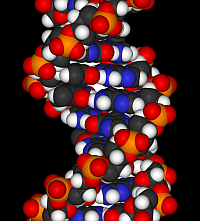Researchers from the St. Jude Children’s Research Hospital – Washington University Pediatric Cancer Genome Project developed a computerized algorithm to better identify genomic properties of cancer cells. Their findings appear in the advance online issue of the journal Nature Methods (paid subscription required).
The analytical methods are contained in a software package called Clipping Reveals Structure, or CREST. Computational biologist Jinghui Zhang, the study’s senior author, says CREST “finds differences between a patient’s normal and cancer genomes other tools cannot find.” Zhang adds, “Similar tools miss up to 60 to 70 percent of these structural rearrangements in tumors.”
The collaboration of St. Jude and Washington University began last year with the goal of sequencing and comparing the complete normal and cancer genomes of 600 young patients with various forms of the disease. The genome project takes advantage of next-generation genome sequencing technology, which has reduced the cost and time needed to determine the order of the four chemical bases that make each person’s DNA unique.
If that order is disrupted, cancer can result. For this project, researchers examine where those disruptions occur, as indicated when a patient’s normal and cancer genomes differ. With CREST, researchers turned to pieces of DNA known as soft clips, the DNA segments produced when sequenced that fail to properly align to the reference human genome as the patient’s genome is reassembled.
Soft clips can be caused by chromosomal rearrangement, but they have many causes and can indicate problems in sequencing data. Other analytic methods discard soft clips, but CREST uses the soft clips to precisely identify sites of chromosomal rearrangement or where pieces of DNA are inserted or deleted.
Where these rearrangements occur, fusion proteins can develop. Zhang says these hybrid proteins fuse pieces of two genes, which can disrupt normal cellular controls and lead to the unchecked cell division that marks cancer.
CREST has already found structural variations in cancer cells that other analytical methods missed. With CREST researchers found 110 structural variations in five acute lymphoblastic leukemia genomes, including 89 variations that scientists validated using other laboratory methods. The researchers say the results were better than the percentage found using other analytic tools.
The team also used CREST to search for structural variations in the published whole-genome sequence of melanoma cells. They discovered 50 previously unidentified variations, selected 20 of those variations for follow-up testing, and validated 18 of the 20 tests.
Downloading and licensing instructions for CREST are found on the St. Jude research Web site.
Read more: Whole Genome Sequencing Advances for Cancer Diagnosis
* * *


 RSS - Posts
RSS - Posts
[…] New Analytical Tools Reveal Cancer DNA Properties […]